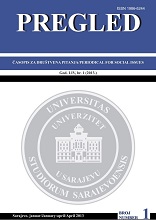Masakr na Markalama, 5. februar 1994.
The Markale Massacre, 5 February 1994
Author(s): Merisa KarovićSubject(s): History
Published by: Univerzitet u Sarajevu
Keywords: The Markale; the siege; Sarajevo; the massacre; civilians; investigations; reports on the crime scene investigation; Ministry of Internal Affairs of the RBiH; UNPROFOR; ICTY
Summary/Abstract: In the context of the Sarajevo siege, indiscriminate shelling and sniping from the position of the ''Sarajevo-Romanija Corps'' on all civilian targets in the city, in the inner part of the Centar and the Stari Grad (Old City) Municipalities, including the streets from the Marin Dvor to the Baščaršija, there were several mass killings of civilians, and many cultural, religious, educational and commercial buildings were damaged or completely destroyed. In this paper we will discuss the Markale massacre perpetrated on the 5th of February 1994, using the analysis of the records on the crime scene investigation of the Prosecution Office, as well as the Police stations of the Ministry of Internal Affairs of the RBiH, performed on the spot immediately after the crime, the Study of the Commission of Experts of the RBiH, as well as documents of the UNPROFOR, which are also related to the investigation after the crime. With the aim of interpretation of the political and military context, and the reaction that followed the massacre, the author first analyzes transcripts from the meetings of the Presidency of the Republic of Bosnia and Herzegovina, the selfproclaimed the Republic of Srpska, meetings of the Supreme Council of Defense of the Federal Republic of Yugoslavia, the available documentation of the “Army of the Republic of Srpska”, the Army of the RBiH, as well as periodicals (daily reports of the UN Commission of Experts, the Oslobođenje - Sarajevo, the Glas Srpski - Banja Luka, and the Politika - Belgrade) and available literature, with special emphasis on the memoirs of senior officials of the United Nations, one of which, to a large extent the military-political situation in Bosnia was dependent on. Reasons to which the investigations of the UNPROFOR were vague and incomplete in terms of the position from which the shells were fired, and whether it was knowingly the question of responsibility of ”both sides” left open, and ultimately, the position of the final judgment of the Hague Tribunal on the crime will be discussed in the final sections of this paper.
Journal: PREGLED - časopis za društvena pitanja
- Issue Year: LIV/2013
- Issue No: 1
- Page Range: 85-112
- Page Count: 28
- Language: Bosnian

